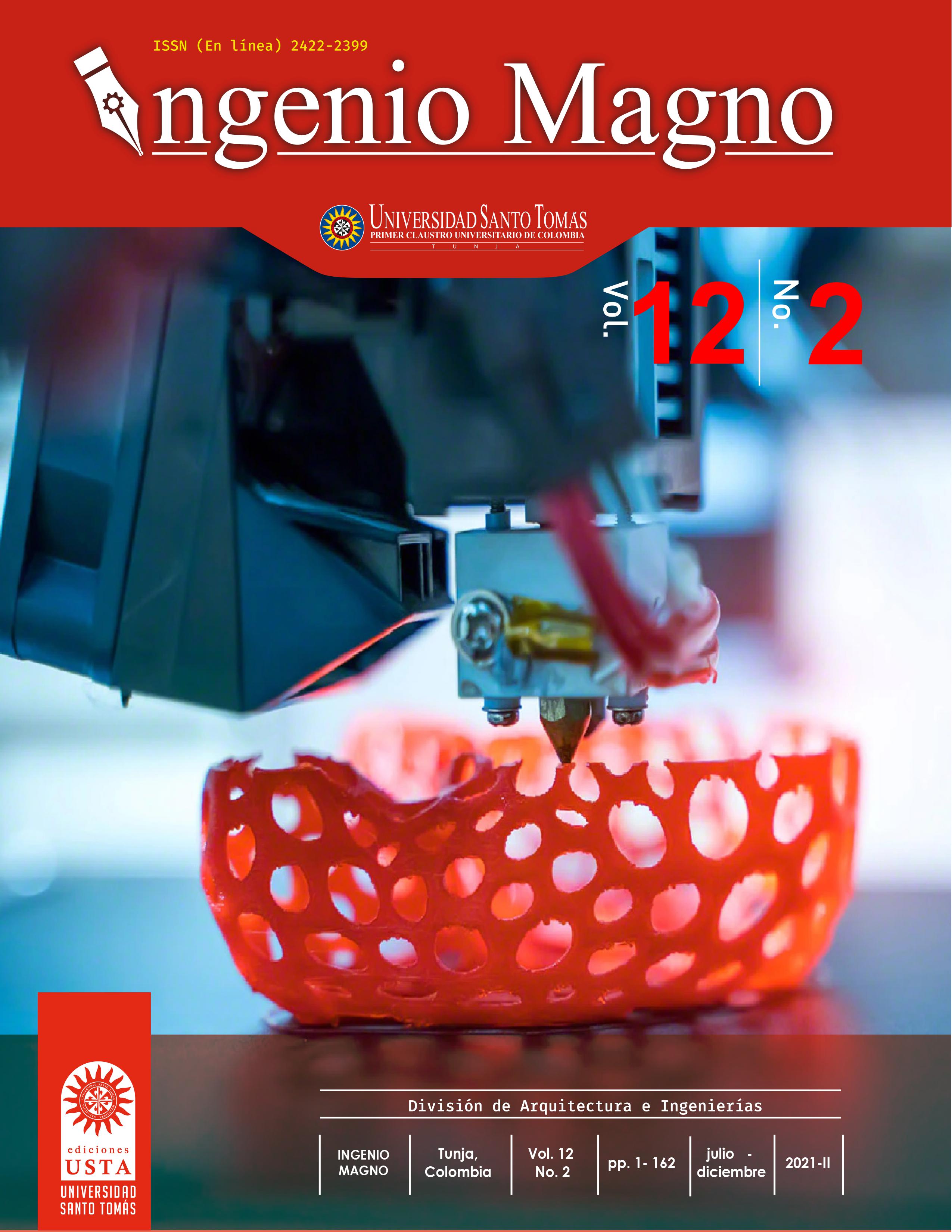Obtaining Biogas From Whey: a Resilient Alternative
Main Article Content
Abstract
Downloads
Article Details
DECLARATION OF ORGINIALITY OF SUBMITTED ARTICLE
With this document, I/We certify that the article submitted for possible publication in the institutional journal INGENIO MAGNO of the Research Center Alberto Magno CIIAM of the University Santo Tomás, Tunja campus, is entirely of my(our) own writing, and is a product of my(our) direct intellectual contribution to knowledge.
All data and references to completed publications are duly identified with their respective bibliographical entries and in the citations thus highlighted. If any adjustment or correction is needed, I(we) will contact the journal authorities in advance.
Due to that stated above, I(we) declare that the entirety of the submitted material is in accordance with applicable laws regarding intellectual and industrial property, and therefore, I(we) hold myself(ourselves) responsible for any complaint related to it.
If the submitted article is published, I(we) declare that I(we) fully relinquish publishing rights of the article to the University Santo Tomás, Tunja campus. As remuneration for this relinquishment of rights, I(we) declare my(our) agreement to receive two (2) copies of the edition of the journal in which my(our) article appears.
References
OCDE & FAO. (2017). OCDE-FAO Perspectivas Agrícolas 2017-2026. Paris. Retrieved from http://www.fao.org/home/search/en/?q=resumen de productos basicos.
Papademas, P., & Kotsaki, P. (2020). Technological Utilization of Whey towards Sustainable Exploitation. Advances in Dairy Research, 7(4), 1–10. https://doi.org/10.35248/2329-888X.19.7.231
Mazorra-Manzano (SNI I), M. Á., & Moreno-Hernández, J. M. (2019). Propiedades y opciones para valorizar el lactosuero de la quesería artesanal. CienciaUAT, 14(1), 133. https://doi.org/10.29059/cienciauat.v14i1.1134
Gosalvitr, P., Cuellar-Franca, R., Smith, R., & Azapagic, A. (2019). Energy demand and carbon footprint of cheddar cheese with energy recovery from cheese whey. Energy Procedia, 161, 10–16. https://doi.org/https://doi.org/10.1016/j.egypro.2019.02.052
Morero, B. D. V. (2014). Purificación de biogás con tecnologías de producción limpias (Doctoral dissertation).
Flórez, J. A. Á. (2005). Motores alternativos de combustión interna. Universitat Politecnica de Catalunya. Iniciativa Digital Politecnica.
Jagatheesan, K., Anand, B., Baskaran, K., Dey, N., Ashour, A. S., & Balas, V. E. (2018). Effect of nonlinearity and boiler dynamics in automatic generation control of multi-area thermal power system with proportional-integral-derivative and ant colony optimization technique. In Recent advances in nonlinear dynamics and synchronization (pp. 89-110). Springer, Cham.
Mendez Castro, C. M. Conceptualización del modelo colombiano de commodities de energía eléctrica teniendo como referencia los mercados norteamericano y español.
Andeg. (2021, 27 octubre). Asociación Nacional de Empresas Generadoras – ANDEG. Recuperado 13 de diciembre de 2021, de https://www.andeg.org/
Kuroki, T., Kabeya, K., Makino, K., Kajihara, T., Kaibe, H. H., Matsuno, H., & Fujibayashi, A. (2014). Thermoelectric Generation Using Waste Heat in Steel Works. Journal of ELECTRONIC MATERIALS, 1-6.
Hegde, S., & Trabold, T. A. (2019). Anaerobic digestion of food waste with unconventional co-substrates for stable biogas production at high organic loading rates. Sustainability (Switzerland), 11(14) doi:10.3390/su11143875.
Ramos-Suárez, J. L., Ritter, A., González, J. M., & Pérez, A. C. (2019). Biogas from animal manure: A sustainable energy opportunity in the Canary Islands. Renewable and Sustainable Energy Reviews, 104, 137-150.
Neshat, S. A., Mohammadi, M., & Najafpour, G. D. (2018). Effect of illumination intensity on photosynthesis assisted anaerobic digestion of cattle manure leachate for enhanced biogas production. Chemical Engineering Journal, 338, 8-14. doi:10.1016/j.cej.2018.01.005
Postawa, K., Szczygieł, J., & Kułażyński, M. (2021). Innovations in anaerobic digestion: A model-based study. Biotechnology for Biofuels, 14(1) doi:10.1186/s13068-020-01864-zSuñol. J. (2001). Rejuvenecimiento facial. Recuperado el 12 de junio de 2001, de http://drsunol.com.
Rezaee, A., Farzadkia, M., Gholami, M., & Kermani, M. (2020). Effect of micro-aerobic process on improvement of anaerobic digestion sewage sludge treatment: flow cytometry and ATP assessment. RSC Advances, 10(59), 35718-35728.
Prabhudessai, V.; Ganguly, A.; Mutnuri, S. (2019). Effect of caffeine and saponin on anaerobic digestion of food waste. Ann. Microbiol. 2009, 59, 643–648.
Sosa, A., Galindo, J., & Bocourt, R. (2007). Metanogénesis ruminal: aspectos generales y manipulación para su control. Revista Cubana de Ciencia Agrícola, 41(2), 105-114.
Christian, S. J., Broeders, E., & Menkveld, H. W. H. (2016). Recovery of ammonia from digestate as fertilizer. Paper presented at the WEFTEC 2016 - 89th Water Environment Federation Annual Technical Exhibition and Conference, 9 932-937. doi:10.2175/193864716819715536.
Tomei, M. C., Angelucci, D. M., & Levantesi, C. (2016). Two-stage anaerobic and post-aerobic mesophilic digestion of sewage sludge: analysis of process performance and hygienization potential. Science of the Total Environment, 545, 453-464.
Climate ORG. (2021, Nov, 11). Clima Sopó (Colombia). [ONLINE]. Available: Https://es.climate-data.org/
FAO. (2021. Dic, 12). Capítulo 4 - control del medio ambiente. ONLINE]. Available: https://www.fao.org/3/s8630s/s8630s06.htm
[añunga, T., Gutiérrez, H. M., Rodríguez, J. A., & Díaz, A. V. (2010). Tratamiento de residuos de DQO generados en laboratorios de análisis ambientales. Ingeniería e investigación, 30(2), 87-95.
Chamorro Guizado, G. N., & Tan Chamaya, J. (2019). Uso de un biorreactor para el tratamiento anaerobio con diferentes tipos de pH para reducir DQO y DBO del lactosuero residual.
Lara, J., Patiño, J. (2012. Costos de inversión, operación y mantenimiento (O & M) de tratamientos naturales de aguas residuales para pequeñas comunidades en Colombia. doi:10.13140/RG.2.1.3439.6642
[arrios, J. A., Cano, A., Rivera, F. F., Cisneros, M. E., & Durán, U. (2021). Efficiency of integrated electrooxidation and anaerobic digestion of waste activated sludge. Biotechnology for Biofuels, 14(1) doi:10.1186/s13068-021-01929-7
Liu, H., Sun, Y., He, X., Zhang, H., Wei, J., & Zhu, L. (2021). Microbiological synthesis of denitrifying bacteria-iron nanopartical composite material and its eminent performance in removal of nitrate-N. Separation and Purification Technology, 267 doi:10.1016/j.seppur.2021.118663
Liu, Z., Stromberg, D., Liu, X., Liao, W., & Liu, Y. (2015). A new multiple-stage electrocoagulation process on anaerobic digestion effluent to simultaneously reclaim water and clean up biogas. Journal of Hazardous Materials, 285, 483-490. Doi: 10.1016/j.jhazmat.2014.10.009

